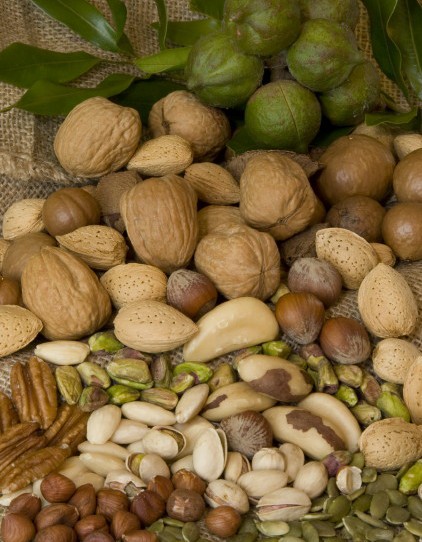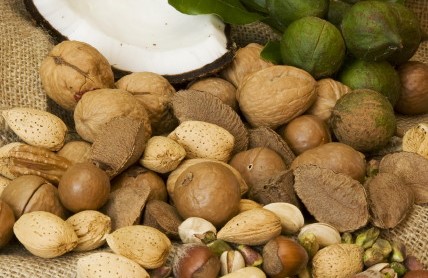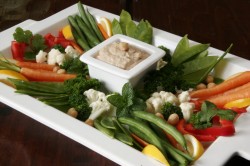A Healthy Kitchen: Ten Nutrition Resolutions

The celebration of the New Year is the oldest of all holidays. It was first observed in ancient Babylon about 4,000 years ago. Their celebration lasted for 11 days, with each day having its own mode of celebration. I think it’s safe to say that modern New Year’s Eve festivities pale in comparison. (And, perhaps, for that we should be thankful!)
Initially, the New Year began with the first new moon after the vernal equinox (the first day of spring), which was a logical time to start a new year. After all, it is the season of rebirth, of planting new crops and of blossoming. The Romans continued to observe the New Year in late March, but their calendar was continually tampered with by various emperors, and the calendar soon became out of sync with the sun.
Certain foods, past and present, are traditional to prepare around the New Year because they are thought to bring luck. Many cultures believe that anything in the shape of a ring is good luck, because it symbolizes “coming full circle,” completing a year’s cycle. For that reason, the Dutch believe that eating donuts on New Year’s Day will bring good fortune. We here at Take The Magic Step™ don’t really cater to that idea, believing it’s luckier to leave the Krispy Kremes alone—depending on variety, just one can pack up to 380 calories and 21 grams of fat! Many parts of the U.S. court Lady Luck by consuming black-eyed peas, typically accompanied by either hog jowls or ham. In Asia, the hog, and thus its meat, is considered lucky because it symbolizes prosperity. Again, not to be a spoil sport, but many cuts of pork, including the jowls, will only increase the size of your jowls! Cabbage is another “good luck” vegetable, considered a sign of prosperity, being representative of paper currency. In some regions, rice is a lucky food that’s eaten on New Year’s Day.
Other traditions of the season include making New Year’s resolutions. This tradition also dates back to the early Babylonians. Popular modern resolutions might include the promise to lose weight or quit smoking. (The early Babylonians’ most popular resolution was to return borrowed farm equipment.)
Ten Magic Nutrition Resolutions
According to Dieter Hogen, running coach and nutritionist to Uta Pippig, the KIMbia runners and other clients, “One thing I know is that, for most people, New Year’s resolutions don’t work; after about 2 weeks they start losing it again.” Dieter’s advice is based on the changes he has made in his own life over the last 15 years. “This is what I focus on and do right now because it makes me feel great and gives me lots of energy.”
1. Drink enough healthy, hydrating fluids throughout the day. Vary your intake with water, fresh-squeezed, diluted fruit juices, freshly made vegetable juices and green tea. First thing in the morning, right after rising, drink 2 cups of water mixed with some freshly squeezed lemon juice (add a touch of orange juice as well, if it’s too sour for you, but not too much as it’s the bitterness that makes this beneficial). Alternatively, drink 1 cup of water with a nice piece of melon.
2. Don’t skip breakfast, and also try to eat three moderate meals and two to three snacks per day. If your morning is hectic or you don’t feel like eating first thing, prepare something the night before and take it with you. Try muesli soaked in soy milk, or make a smoothie made with yogurt and whey protein or fermented soy protein (an easier-to-digest form of organic soy milk that’s fermented (predigested) using probiotic bacteria). “What hard cases might want to consider,” says Hogen, “is eating an apple and a good nutrition bar like Odwalla, one that has oats listed as the first ingredient, on your commute to work.” For more on Dieter’s breakfast recipes, read “Kick Start Your Day“.
3. Make veggies—both raw and cooked—your number one carbohydrate source. Eat a colorful array, especially of the dark green vegetables. The different colored vegetables all have unique combinations of antioxidants.
4. Avoid as much “bad fat” as you can—those coming from too much meat, dairy products, and baked or fried goods. Make sure you get at least 2 grams of omega-3 fatty acids (EPA/DHA) from fatty fish or molecular distilled fish oil supplements (which contain the healthful fatty acids but have been stripped of potential pollutants) every day.
5. Supplements can be helpful, but don’t take them as an alternative to bad eating habits; it won’t work.
Some of Uta’s favorite tips that work for her:
6. First and foremost, enjoy your food! That means eating consciously, slowly and appreciating the colors, textures and aromas of your meal.
7. When buying fresh fruits, use your nose. Look for sweet, full aromas. The best is usually what’s in season in your area.
8. Make eating a celebration. Even when eating alone, you can set a nice table with candles and/or flowers.
And finally, what works for me:
9. Take a pause before starting your meal. Even if it’s only for a few seconds, just shut your eyes, take a deep breath and connect with yourself. You’ll find this helps you eat mindfully and minimize overeating. And remember—guilt is counterproductive. Don’t let a slip-up discourage you. Just eat more lightly the next day.
10. If resolving to lose weight or eat more healthfully, do it for yourself.Resolutions rarely stick if you’re doing them for someone else. If cutting out certain foods, shift your awareness from the idea of denying or restricting yourself to how eating better feeds you positively, and in so many ways. Eating well is one of life’s greatest gifts you can give yourself.
The following recipe is guaranteed to bring you health and good luck in the new year! (Well, good health anyway.)
Steamed Ginger-Garlic Salmon
Rich, succulent salmon is high in heart and brain-healthy omega-3 fatty acids. Here, it’s gently steamed and seasoned with an easy blend of Asian flavorings. This is delicious served with steamed prosperity-promoting baby bok choy or other greens and nutty brown rice.
Ginger-Garlic Marinade: 2 tablespoons rice wine or sake 1½ tablespoons tamari or soy sauce 1 tablespoon each minced fresh ginger and garlic 1 teaspoon toasted sesame oil 6 wild-caught salmon steaks (about 6 ounces each) 2 tablespoons chicken broth 3 tablespoons finely shredded scallions, white part only ¼ teaspoon freshly ground black pepper
Make marinade: In a large bowl whisk together the rice wine, tamari, ginger, garlic and sesame oil.
Rinse the fish well under cold water, pat dry with paper towel and then add to the marinade. Gently stir the fish to coat with marinade. Cover with plastic wrap and refrigerate at least 10 minutes or up to one hour.
Arrange the salmon on a heatproof plate and place in a steamer tray or on a rack. Pour enough water into a large pot and bring to a boil. Carefully place the tray or rack with salmon over the water and steam until the fish flakes with a fork, about 10 minutes.
Just before the salmon is done bring the chicken broth to a boil in a small pot. Transfer the salmon to a platter and slowly pour the hot broth over the fish. Sprinkle the fish with scallions and pepper.
Makes 6 servings.
Updated November 1, 2011
- Posted January 10, 2007
© Copyright 2006-2025 Take The Magic Step®. All Rights Reserved.




